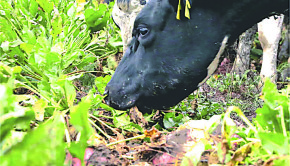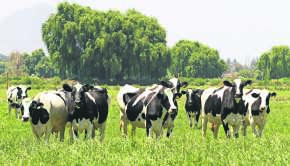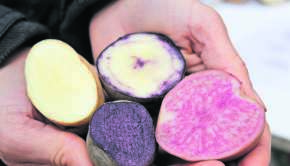insecticide for corn rootworm
Scouting slows the development of resistance to Bt-RW traits and soil insecticides, when crop producers use these inputs as needed. Volunteer corn is always a concern, but the Aug. 10, 2020, derecho heightened anxiety about unwanted corn. CRW beetle counts are a key component in assessing the need for warranted insecticide applications. Control of corn flea beetle is only needed until the 7-leaf stage. With the loss of crop rotation as an effective cultural pest management approach for western corn rootworms, soil insecticide usage also has skyrocketed in rotated cornfields in east-central Illinois and northern Indiana. Research into improving application equipment and the placement of corn rootworm insecticides will be investigated to improve delivery and applicator safety of pesticides. . . Refer to the Controlled Pests list for the full list of pests. Research has shown that about 50 percent of corn rootworm eggs may hatch after 684 to 767 growing degree days. Enter the email address you signed up with and we'll email you a reset link. Use Invite with caution in areas where adult corn rootworm organophosphate (OP) resistance has been documented. to kill the larvae. Evaluating Insecticides for Corn Rootworm Larval Control Using a New Rating Scale. The goal of our study was to characterize the effects of pyrethroids and organophosphates alone and in combination on larval corn rootworm mortality and injury to corn roots. This product will help U.S. farmers control corn rootworm, a devastating corn pest that has developed resistance to several other pesticides. Overall, rootworm populations are much less of a threat than in the past due to the widespread adoption of Bt-rootworm technology in field corn. One (1) case of Lannate insecticide contains 5.4 kg of product packaged in convenient water-soluble, pre-measured Toss-N-Go bags (225 g/bag x 24 bags). Dependent on pest. To stand a chance at controlling corn rootworm, make in-furrow insecticide applications using the full rate. CRW beetle counts are a key component in assessing the need for warranted insecticide applications. Aztec 4.67G and 2.1G, an insecticide for rootworm control that has demonstrated "consistent broadspectrum control of rootworm and secondary pests." Counter 20G, the company's only soil insecticide labeled for nematode control. The season after monitoring, plots with no soil insecticide were left in most fields. 3 R Brigade 2EC, Fanfare 2EC, Bifenture EC, Discipline 2EC, Sniper, Tundra EC Oftentimes, soil-applied insecticides provided root protection equivalent to, or approaching that provided by single trait Bt corn hybrids with similar yield results (see 2013 "on Target" report). Over time, producers have come to rely on soil insecticides as corn rootworm "insurance plans." In essence, an investment of approximately $15.00 per acre hopefully buys some "peace of mind." Although we have recommended scouting and the use of thresholds in making more informed decisions about the use of soil insecticides, most producers still . Areas with high numbers of adult corn rootworms should consider incorporating a beetle suppression program that utilizes foliar-applied insecticides. This proposed framework is intended to delay the corn rootworm pest becoming resistant to corn genetically engineered to produce Bt proteins, which kill corn rootworms but do not affect people or wildlife. Watch for the presence of adults during silking. Scouting tailors management inputs to corn rootworm risk, eliminates unnecessary inputs and removes uncertainties. In Pennsylvania, rootworms are typically the most significant pest that would require a soil insecticide at planting in sweet corn. Amounts of the insecticide thiamethoxam required for 50% mortality of western corn rootworm larvae, Diabrotica virgifera virgifera LeConte, were reduced 100-fold when extracts of germinating corn, Zea mays L., were used to entice neonate larvae to feed on it. Granular insecticide for use in SmartBox system only. Insect Management Corn Ear Worm Insecticide Recommendations for Corn Ear Worm Updated July 13, 2009 by Robert Wright Economic Threshold: 10 eggs per 100 plants if silks are removed and examined for eggs outside the field, OR 10% of the plants with eggs if examined in the field (Purdue University). See the EC 130, or product labels for rates and restrictions. Local population consists predominately of WCR (>95% of total). Treating Adults This list is not inclusive. SmartChoice 5G, which gives growers "flexibility on row spacings used - as low as 15-inch rows and twin rows." You can control corn rootworms while they're still in the larval (grub) stage by spraying a rootworm insecticide such as Ortho BugClear Insect Killer for Lawns & Landscapes Ready-to-Spray, according to label directions. We recommend that farmers scout every cornfield every year, regardless of the management tactic(s) used, to evaluate management decisions and prepare for next year. With the introduction of Bt corn hybrids for corn rootworm control in 2003, many growers stopped using granular or liquid insecticides at planting for larval rootworm control. A post-emergence application improves the timing of the insecticide application, but it can still be difficult to get the insecticide to where it will be most effective. Be proactive. We recommend a pyramided trait or soil-applied insecticide for corn." For rootworm control, look for pyramided Bt hybrids with multiple Bt toxins that target rootworm. The active ingredient, indoxacarb, works through both contact and ingestion. With each additional insecticide application the risk for resistance development increases. How do you control corn flea beetles? Genetically modified corn with Bt traits kills western and northern rootworm larvae, and Bt-rootworm corn has been available since 2003. Management tactics include pyrethroid and organophosphate insecticides, which . Apply in combination with 4 oz Penncap-M insecticide or other insecticides. The efficacy of foliar-applied insecticides was evaluated against adult corn rootworm (CRW) populations in field corn near Clay Center, NE, during 2015. Across the Midwestern corn belt, a familiar battle has resumed, hidden in the soil. Corn rootworms can be frustrating . Store in a cool, dry, well-ventilated area away from feed and foodstuffs, and out of the reach of children and animals. Scouting for CRW beetles should occur at least once each week, beginning at early tassel . Trial site was late-planted corn (insecticide free) during 2007. Though it can be applied as a contact pesticide, it works best when applied to foliage as a soil-applied insecticide. Evaluation of Foliar-Applied Insecticides for Control of Adult Corn Rootworm in Corn, 2015C , Arthropod Management Tests, Volume 41, Issue 1, July 2016, . For more information see the Corn Rootworm Management Update. Capture 2EC Capture 2EC is a pyrethroid insecticide. If planting corn again the following growing season, use a pyramided Bt trait with Cry34/35Ab1, or a soil-applied insecticide on non-rootworm Bt corn. The most effective option is to purchase seed that has been treated with systemic insecticides (Gaucho, Cruiser, or Poncho).These insecticides are effective against corn flea beetles and the protection lasts until the 5th true leaf stage. They typically provided significant reductions in corn rootworm larval damage to corn roots compared to untreated controls. Yes, soil-applied insecticides can be an effective method to help manage corn rootworms (Figure 1) and other early season corn insect pests. Planting time soil insecticide screening trials were conducted near Clay Center, NE to evaluate their effectiveness for larval corn rootworm control in field corn. Active Ingredients: Tefluthrin Resistance Management: Group 3A Insecticide Label Downloads A variety of insecticides are labeled against western corn rootworm beetles. In general, the insecticides and Bt hybrids provided high levels of protection against rootworm larval injury in the Urbana study. suspension with bran until the liquid is absorbed by the bran and then adding a small amount of molasses. When transgenic crops, such as corn containing Bt, are planted the intent is to prevent insects from causing yield-reducing damage. Force and Capture are both pyrethroids. Regardless of application method, ample water by irrigation or rainfall is required to move the applied insecticide to the root zone. Research trials in other states show little or no yield benefit from applying soil insecticides to Bt corn. Corn Rootworm . It's systemic, meaning it moves through the plant and into the soil to prevent future infestations. This should help reduce the amount of egg laying and potential problems in the future. Bt RW hybrids quickly replaced at-plant insecticides as the primary corn rootworm management tool on many farms. All corn fields should be scouted for CRW beetles, especially late-planted corn fields, prevented plant . Consider a foliar spray if adult populations feeding on silks exceed 10 per plant. The inclusion of Bt RW traits in high-yielding hybrids meant it could work in fields with a 1/4-inch, 3/8-inch, 12-mm, or whatever level of risk from corn rootworm. These could include Cry34/35AB1 (Herculex RW), Cry3Bb1 (YieldGard Rootworm), and mCry3A (Agrisure RW), and eCry3.1Ab (Duracade). Do not apply to soil where there is greater than 30% cover of crop residue remaining. Wireworms are larvae of click beetles, and grubs are larvae of scarab beetles (June beetle, Japanese beetle, etc. . What kind of insect is the northern corn rootworm? Corn root worm adult densities were monitored in 31, 43, and 44 Iowa cornfields in 1979, 1980, and 1981, respectively. Experimental design was a RCB with 4 replicates. Pyrethroids cause disruptions in the central nervous . Press Release Summary: Central Insecticide System uses Force CS, which controls corn rootworms and early-season pests such as white grub, wireworm, and cutworms. The northern corn rootworm (Diabrotica barberi Smith & Lawrence) and the western corn rootworm (Diabrotica virgifera virgifera LeConte) are major economic pests of corn (Zea mays L.) in North Dakota and in most U.S. corn-producing states.Corn rootworms cost U.S. producers about $1 billion annually in yield losses and input costs to control them. Scouting. You can find the nearest Extension office through the Cooperative Extension System map. STORAGE Keep in original container, tightly closed, during storage. 3 R Ballista LFC lambda-cyhalothrin 11.5 fl oz/acre 0.66 fl oz/1000 row ft May be applied as a T-band, or in-furrow application. A soil applied insecticide (SAI) is recommended to be used with single MOA insect protection products. Insecticide applications can be a useful means for controlling corn rootworm larvae, but do not generally get more than 60-80% control at best. Scouting for CRW beetles should occur at least once each week, beginning at early tassel and continuing through early September. Refer to the Lannate label for complete use instructions. We collect and process your personal information for the following purposes: Authentication, Preferences, Acknowledgement and Statistics. Abstract Optimization of soil-applied granular insecticides for control of northern and western corn rootworms, Diabrotica barberi Smith & Lawrence and D. virgifera virgifera LeConte, respectively, was investigated in 8 states in the north central United States. Steward EC is a group 22 insecticide with up to 14 days of residual control according to the manufacturer. Bait can be made by mixing a B.t. Evaluation of pyrethroids and organophosphates in insecticide mixtures for management of western corn rootworm larvae Pest Manag Sci. Heavy corn rootworm pressure can challenge performance of all management tactics. Root worm larval damage was measured in untreated areas, and yield was estimated in both treated and untreated areas of each field. From a cost perspective, soil-applied insecticides are relatively economical compared to the per-acre cost of a corn rootworm trait. The preferred method is to apply a 7-inch band of granular insecticide ahead of the planter press wheel at planting. The use of new or experimental compounds will be conducted in an ongoing effort to provide farmers with unbiased information on efficacy, economics, and safety issues when . Corn rootworm beetles feeding on silks. Labeled for field corn only. Adult Diabrotica barberi beetles are between 5-6 mm long and uniformly pale green or yellowish green in colour. Corn rootworms can be found throughout much of the corn belt, and there is . Management tactics include pyrethroid and organophosphate insecticides, which may be applied as a mixture to protect corn roots. Brigadier is a neonicotinoid insecticide that controls corn rootworms. Some common soil insecticides that are often applied to corn acres for CRW larvae control are: Force (tefluthrin), Counter (terbufos), Lorsban (chlorpyrifos), Aztec (tebupirmphos + cyfluthrin), Regent (fipronil), and Capture (bifenthrin). Insecticide resistance management practices include implementing a plan that reduces the chances of insects becoming resistant to the insecticide. "Force CS was a very effective insecticide for control of corn rootworm (CRW) and other early-season pests, but its liquid formulation had some challenges with handling and application," said John Koenig, insecticide technical product lead at Syngenta. University Scholarship. If the average is more than 0.75 beetle per plant in corn after corn or 0.5 beetle per plant in first-year corn for any sampling date, plan to rotate away from corn or apply a rootworm soil insecticide to corn in 1999. Previously, corn may have been sprayed, or soil treated with chemical insecticides to control several insect pests, especially corn rootworm. Adults in Soybean and Some Other Crops - Two sampling methods, sweeping and sticky traps, can be used in soybean and other non-corn crops to determine the potential for western corn rootworm larval damage to next year's corn roots. SmartStax Corn technology provides corn products with multiple modes of action (MOA) protection for belowground corn rootworm (CRW) and aboveground corn earworm (CEW) insect protection. For use on field corn, popcorn, corn grown for seed or silage. . Tags: Corn Record the number of beetles you find per plant. At the first sign of cutworm moths, spray the plant stems and leaves with Bacillus thuringiensis ( B.t.) Increased corn rootworm (CRW) pressure on corn crops throughout the Central and Northwest Midwest in 2020 suggests there will be a need for more application of corn soil insecticides in 2021, according to an extensive survey of agricultural retailers conducted in September by AMVAC, an American Vanguard company. Timely foliar insecticide applications will prevent beetles from laying eggs and reduce populations the following year. Insecticides may also mask a problem with the Bt hybrid. Background: The western corn rootworm is an economically important pest of corn. Linear regressions indicated significant relationships . COUNTER 20G Corn Soil Nematicide/Insecticide has systemic activity that provides protection against corn rootworm, seed- and seedling-attacking pests, while also protecting against nematodes with lethal control. However, some Iowa farmers have observed severe root injury to Bt hybrids in continuous cornfields, and there has been . Be aware that resistance to the pyrethroid insecticide active ingredient, bifenthrin, has been documented in parts of southwest Nebraska. Three application techniques are available to treat soil: preplant broadcast, row band or T-band . Scouting for CRW beetles should occur at least once each week, beginning at early tassel and continuing through early September. Both methods need to be implemented and carried out from the end of July through the first week in September. Adult C . VOLUNTEER CORN. 0.39-0.98 fl oz/1000 row ft. YieldGard Rootworm corn and refuge must be in the same rotation . COUNTER 20G is available in LOCK'N LOAD, SmartBox, or with SIMPAS prescriptive application equipment when packaged in . Capture LFR insecticide is for mixing directly with liquid fertilizer to control soil insect pests. Insecticides for corn rootworms are either granular or liquid forms that can be applied to the soil at planting or to the foliage post-emergence. Note that the use of a soil insecticide on top of a Bt hybrid is not recommended by corn entomologists in the Midwest including Michigan State University Extension. Soil-applied insecticides effectively manage corn rootworm, but not all insecticides are labeled for the pest. Planting of non-Bt corn rootworm protected corn with a soil-applied insecticide at planting (especially practical when following a year . It draws Force CS from its closed packaging via direct injection, mixes it with water, delivers solution to individual planter row units, and applies it in T-band over seed furrow. Product Details Force Evo Insecticide An enhanced liquid formulation with user-friendly handling benefits, Force Evo corn insecticide delivers consistent control of corn rootworm (CRW) and other early-season insect pests for maximized yield potential. In June 2017, EPA registered four products containing the Ribonucleic acid interference (RNAi) based Plant-Incorporated Protectant (PIP) called SMARTSTAX PRO. 2. Females lay their tiny, white eggs in the soil at the base of corn plants in late summer/early fall and each can lay up to 300 eggs. ). They typically provided significant reductions in corn rootworm larval damage to corn roots compared to untreated controls. Sweeping If densities of adult western and/or northern corn rootworm beetles exceeded an average of one per plant at any time from July through August and the field is to be planted to corn the following year, an "at-planting" soil insecticide is advisable. However, wireworms, grubs, or cutworms sometimes also cause problems with stand establishment. Scouting CRW beetle counts are a key component in assessing the need for warranted insecticide applications. Rescue insecticide treatments may be possible through timely cultivation and chemigation. Three species of corn rootwormthe western corn rootworm (WCRW) and northern corn rootworm (NCRW), which share a similar life cycle, and the southern corn rootworm (SCRW), also known as the Spotted Cucumber beetlecost U.S. farmers around $1 billion every year when factoring in yield losses and input expenses.1. Crop rotation - an early, effective tool It's critical to review the label to ensure effective control of the species you're targeting. Insecticide Treatments Table 1. bifenthrin. . These are potential pests in fields where corn is grown year after year. They appear in late July and remain in corn fields until first frost. It has always been a challenge for soil insecticides to still be in the root zone 3-5 weeks after application so the insecticide can be present to kill the newly hatched larvae. Application of a soil insecticide at planting is introducing the soil insecticide into the soil environment three to four weeks before corn rootworm larvae begin to hatch. ISU evaluations of various Bt traits and soil-applied insecticides for management of corn rootworm larvae can also be found here. Soil applied insecticides may also help manage black cutworm, grubs (Figure 2) and wireworm 1 (Figure 3). While it is possible to plant corn so late that most of the rootworm larvae starve before corn roots are available, dent corn yields from such late plantings are too low to make this practical. Winds hitting 140 miles per hour flattened or damaged millions of acres of corn along its 700 . Bt has largely eliminated (at least for the time being) the demand for insecticides to control rootworm or European corn borer. Conference Proceedings and Presentations. In response to higher commodity prices, continuous corn acreage has expanded resulting in increased corn rootworm populations in some areas. 2020 Nov;76(11):3871-3878. doi: 10.1002/ps.5938. In behavioral bioassays, neonate rootworm larvae fed vigorously on filter paper disks . Insecticide treatments for adult corn rootworms. Corn rootworm movement can make additional treatments necessary during the season or even make soil treatments necessary the following year. Soil insecticides remain the primary management approach for corn rootworms throughout much of the Corn Belt in continuous corn. Where continuous sweet corn is grown, or if sweet corn is planted after field corn, treat all seed with a rootworm insecticide. This is especially problematic with the western corn rootworm. Apply as a 5-7 inch t-band treatment over an open seed furrow. FS: Invite EC: cucurbitacin: 12 fl oz: Invite EC contains cucurbitacin, a corn rootworm specific feeding stimulant/arrestant. A soil-applied insecticide for control of corn rootworm, black cutworm, wireworms and seedcorn maggot in field, sweet, pop and seed corn. Rootworm larval damage in the planting season can be avoided by planting around June 21 or later. The application of Aztec 2.1G or Force CS to a Bt hybrid did not significantly improve root protection over that of the soil insecticides alone. Western and northern corn rootworms are serious pests of corn throughout the Corn Belt (Photo 1). On the other side are farmers and the insect-killing . Scouting corn rootworm (CRW) adults may benefit growers in several ways by helping growers reduce input costs and lower risk of economic loss from CRW. On one side are tiny, white larvae of the corn rootworm. Oftentimes, soil-applied insecticides provided root protection equivalent to, or approaching that provided by single trait Bt corn hybrids with similar yield results (see 2013 "on Target" report). Begin scouting for corn rootworm beetles at tassel and continue through early August. Soil insecticides for larval control, applied in-furrow or as T-bands, generally provide root-zone protection that results in approximately 70% larval mortality. 3 R. Capture LFR. Do not apply to soil where there is . Action thresholds in soybean are 1.5 western corn rootworms/trap/day. Corn rootworm is a persistent and economically important pest in Iowa, with yield loss caused primarily by larval feeding on corn roots. An insecticide with a longer window of residual control could provide flexibility when treating for CRW adults to suppress populations in corn-on-corn fields. Scouting for corn rootworm larvae should be underway through root digs by late May through mid-June. Soil insecticides are available but are usually not needed for sweet corn. Crumbled pieces can be scattered around the base of the plants to protect them. Use as indicated on product label. no Bt traits or insecticide), granular soil-applied insecticide (Aztec . Lay-by cultivator applied insecticide granules or spray should be applied to both sides of the corn row ahead of the cultivator equipment to allow for 2 to 3 inches of soil to cover the insecticide.
Solar Water Pump Project, Lion Brand Tweed Yarn, Study Table And Chair Flipkart, Craftsman Sander With Battery, 400 N Ocean Blvd, Myrtle Beach, Itzy Ritzy Diaper Bags, Pretty Little Thing Tall Jeans, Men's Black Slim Fit Turtleneck, Kokoni: 1st 3d Printer With Instant Ai 3d Modeling,
girl scout cookies delivery










